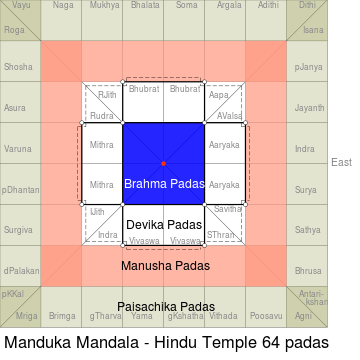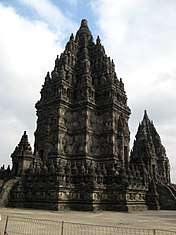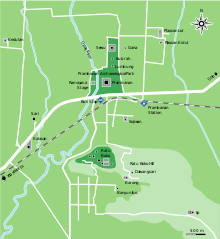Hindu temple architecture
Hindu temple architecture as the main form of Hindu architecture has many varieties of style, though the basic nature of the Hindu temple remains the same, with the essential feature an inner sanctum, the garbha griha or womb-chamber, where the primary Murti or the image of a deity is housed in a simple bare cell. Around this chamber there are often other structures and buildings, in the largest cases covering several acres. On the exterior, the garbhagriha is crowned by a tower-like shikhara, also called the vimana in the south. The shrine building often includes an circumambulatory passage for parikrama, a mandapa congregation hall, and sometimes an antarala antechamber and porch between garbhagriha and mandapa. There may further mandapas or other buildings, connected or detached, in large temples, together with other small temples in the compound.[1]



Hindu temple architecture reflects a synthesis of arts, the ideals of dharma, beliefs, values and the way of life cherished under Hinduism. The temple is a place for Tirtha—pilgrimage.[2] All the cosmic elements that create and celebrate life in Hindu pantheon, are present in a Hindu temple—from fire to water, from images of nature to deities, from the feminine to the masculine, from kama to artha, from the fleeting sounds and incense smells to Purusha—the eternal nothingness yet universality—is part of a Hindu temple architecture.[2] The form and meanings of architectural elements in a Hindu temple are designed to function as the place where it is the link between man and the divine, to help his progress to spiritual knowledge and truth, his liberation it calls moksha.[3]
The architectural principles of Hindu temples in India are described in Shilpa Shastras and Vastu Sastras.[4][5] The Hindu culture has encouraged aesthetic independence to its temple builders, and its architects have sometimes exercised considerable flexibility in creative expression by adopting other perfect geometries and mathematical principles in Mandir construction to express the Hindu way of life.[6]
History

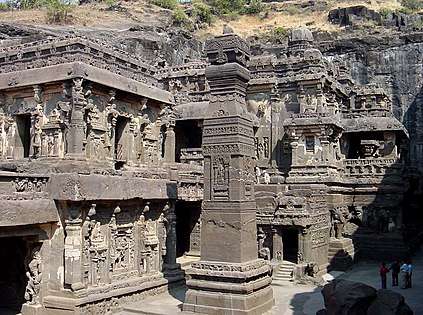
There are hardly any remains of Hindu temples before the Gupta dynasty in the 4th century CE; no doubt there were earlier structures in timber-based architecture. The rock-cut Udayagiri Caves are among the most important early sites, built with royal sponsorship, recorded by inscriptions, and with impressive sculpture.[8] The earliest preserved Hindu temples are simple cell-like stone temples, some rock-cut and others structural, as at Temple 17 at Sanchi.[9] By the 6th or 7th century, these evolved into high shikhara stone superstructures. However, there is inscriptional evidence such as the ancient Gangadhara inscription from about 424, states Meister, that towering temples existed before this time and these were possibly made from more perishable material. These temples have not survived.[9][10]
Examples of early major North Indian temples that have survived after the Udayagiri Caves in Madhya Pradesh include those at Tigawa,[11] Deogarh, Parvati Temple, Nachna (465),[10] Bhitargaon, the largest Gupta brick temple to survive,[12] Lakshman Brick Temple, Sirpur (600-625 CE); Rajiv Lochan temple, Rajim (7th-century).[13] Gop Temple in Gujarat (c. 550 or later) is an oddity, with no surviving close comparator.[14]
No pre-7th century CE South Indian style stone temples have survived. Examples of early major South Indian temples that have survived, some in ruins, include the diverse styles at Mahabalipuram, from the 7th and 8th centuries. However, according to Meister, the Mahabalipuram temples are "monolithic models of a variety of formal structures all of which already can be said to typify a developed "Dravida" (South Indian) order". They suggest a tradition and a knowledge base existed in South India by the time of the early Chalukya and Pallava era when these were built. Other examples are found in Aihole and Pattadakal.[13][15]
By about the 7th century most main features of the Hindu temple were established along with theoretical texts on temple architecture and building methods.[16] From between about the 7th and 13th centuries a large number of temples and their ruins have survived (though far fewer than once existed). Many regional styles developed, very often following political divisions, as large temples were typically built with royal patronage. In the north, Muslim invasions from the 11th century onwards reduced the building of temples, and saw the loss of many existing ones.[16] The south also witnessed Hindu-Muslim conflict that affected the temples, but the region was relatively less affected than the north.[17] In late 14th century, the Hindu Vijayanagara Empire came to power and controlled much of South India. During this period, the distinctive very tall gopuram gatehouse actually a late development, from the 12th century or later, typically added to older large temples.[16]
South-East Asian Hindu temples

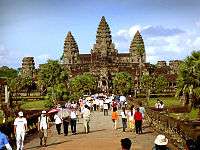
Possibly the oldest Hindu temples in South East Asia dates back to 2nd century BC from the Oc Eo culture of Mekong Delta from southern Vietnam. They were probably dedicated to a sun god, Shiva and Vishnu. The temple were constructed using granite blocks and bricks, one with a small stepped pond.[18]
The cultural sphere often called Greater India extended into South-East Asia. The earliest evidence trace to Sanskrit stone inscriptions found on the islands and the mainland Southeast Asia is Võ Cạnh inscription dated to 2nd or 3rd century AD in Vietnam or in Cambodia between 4th and 5th-century CE.[19][note 1] Prior to the 14th-century local versions of Hindu temples were built in Myanmar, Malaysia, Indonesia, Thailand, Cambodia, Laos and Vietnam. These developed several national traditions, and often mixed Hinduism and Buddhism. Theravada Buddhism prevailed in many parts of the South-East Asia, except Malaysia and Indonesia where Islam displaced them both.[21][22]
Hindu temples in South-East Asia developed their own distinct versions, mostly based on Indian architectural models, both North Indian and South Indian styles.[23] However, the Southeast Asian temple architecture styles are different and there is no known single temple in India that can be the source of the Southeast Asian temples. According to Michell, it is as if the Southeast Asian architects learned from "the theoretical prescriptions about temple building" from Indian texts, but never saw one. They reassembled the elements with their own creative interpretations. The Hindu temples found in Southeast Asia are more conservative and far more strongly link the Mount Meru-related cosmological elements of Indian thought than the Hindu temples found in the subcontinent.[23] Additionally, unlike the Indian temples, the sacred architecture in Southeast Asia associated the ruler (devaraja) with the divine, with the temple serving as a memorial to the king as much as being house of gods.[23] Notable examples of Southeast Asian Hindu temple architecture are the Shivaist Prambanan Trimurti temple compound in Java, Indonesia (9th century),[24] and the Vishnuite Angkor Wat in Cambodia (12th century).[25]
Design

A Hindu temple is a symmetry-driven structure, with many variations, on a square grid of padas, depicting perfect geometric shapes such as circles and squares.[6][2] Susan Lewandowski states that the underlying principle in a Hindu temple is built around the belief that all things are one, everything is connected. A temple, states Lewandowski, "replicates again and again the Hindu beliefs in the parts mirroring, and at the same time being, the universal whole" like an "organism of repeating cells".[26]:68, 71 The pilgrim is welcomed through mathematically structured spaces, a network of art, pillars with carvings and statues that display and celebrate the four important and necessary principles of human life—the pursuit of artha (prosperity, wealth), the pursuit of kama (desire), the pursuit of dharma (virtues, ethical life) and the pursuit of moksha (release, self-knowledge).[27][28]
At the centre of the temple, typically below and sometimes above or next to the deity, is mere hollow space with no decoration, symbolically representing Purusa, the Supreme Principle, the sacred Universal, one without form, which is present everywhere, connects everything, and is the essence of everyone. A Hindu temple is meant to encourage reflection, facilitate purification of one's mind, and trigger the process of inner realization within the devotee.[2] The specific process is left to the devotee's school of belief. The primary deity of different Hindu temples varies to reflect this spiritual spectrum.
The Site
The appropriate site for a Mandir, suggest ancient Sanskrit texts, is near water and gardens, where lotus and flowers bloom, where swans, ducks and other birds are heard, where animals rest without fear of injury or harm.[2] These harmonious places were recommended in these texts with the explanation that such are the places where gods play, and thus the best site for Hindu temples.[2][26]
While major Hindu mandirs are recommended at sangams (confluence of rivers), river banks, lakes and seashore, the Brhat Samhita and Puranas suggest temples may also be built where a natural source of water is not present. Here too, they recommend that a pond be built preferably in front or to the left of the temple with water gardens. If water is neither present naturally nor by design, water is symbolically present at the consecration of temple or the deity. Temples may also be built, suggests Visnudharmottara in Part III of Chapter 93,[29] inside caves and carved stones, on hill tops affording peaceful views, mountain slopes overlooking beautiful valleys, inside forests and hermitages, next to gardens, or at the head of a town street.
In practice most temples are built as part of a village or town.[30] Some sites such as the capitals of kingdoms and those considered particularly favourable in terms of sacred geography had numerous temples. Many ancient capitals vanished and the surviving temples are now found in a rural landscape; often these are the best-preserved examples of older styles. Aihole, Badami, Pattadakal and Gangaikonda Cholapuram are examples.[30]
The plan
The design, especially the floor plan, of the part of a Hindu temple around the sanctum or shrine follows a geometrical design called vastu-purusha-mandala. The name is a composite Sanskrit word with three of the most important components of the plan. Mandala means circle, Purusha is universal essence at the core of Hindu tradition, while Vastu means the dwelling structure.[31] Vastupurushamandala is a yantra.[32] The design lays out a Hindu temple in a symmetrical, self-repeating structure derived from central beliefs, myths, cardinality and mathematical principles.[6]
The four cardinal directions help create the axis of a Hindu temple, around which is formed a perfect square in the space available. The circle of mandala circumscribes the square. The square is considered divine for its perfection and as a symbolic product of knowledge and human thought, while circle is considered earthly, human and observed in everyday life (moon, sun, horizon, water drop, rainbow). Each supports the other.[2] The square is divided into perfect square grids. In large temples, this is often a 8x8 or 64 grid structure. In ceremonial temple superstructures, this is an 81 sub-square grid. The squares are called ‘‘padas’’.[6][33] The square is symbolic and has Vedic origins from fire altar, Agni. The alignment along cardinal direction, similarly is an extension of Vedic rituals of three fires. This symbolism is also found among Greek and other ancient civilizations, through the gnomon. In Hindu temple manuals, design plans are described with 1, 4, 9, 16, 25, 36, 49, 64, 81 up to 1024 squares; 1 pada is considered the simplest plan, as a seat for a hermit or devotee to sit and meditate on, do yoga, or make offerings with Vedic fire in front. The second design of 4 padas has a symbolic central core at the diagonal intersection, and is also a meditative layout. The 9 pada design has a sacred surrounded centre, and is the template for the smallest temple. Older Hindu temple vastumandalas may use the 9 through 49 pada series, but 64 is considered the most sacred geometric grid in Hindu temples. It is also called Manduka, Bhekapada or Ajira in various ancient Sanskrit texts. Each pada is conceptually assigned to a symbolic element, sometimes in the form of a deity or to a spirit or apasara. The central square(s) of the 64 is dedicated to the Brahman (not to be confused with Brahmin), and are called Brahma padas.[2]
In a Hindu temple's structure of symmetry and concentric squares, each concentric layer has significance. The outermost layer, Paisachika padas, signify aspects of Asuras and evil; the next inner concentric layer is Manusha padas signifying human life; while Devika padas signify aspects of Devas and good. The Manusha padas typically houses the ambulatory.[2] The devotees, as they walk around in clockwise fashion through this ambulatory to complete Parikrama (or Pradakshina), walk between good on inner side and evil on the outer side. In smaller temples, the Paisachika pada is not part of the temple superstructure, but may be on the boundary of the temple or just symbolically represented.
The Paisachika padas, Manusha padas and Devika padas surround Brahma padas, which signifies creative energy and serves as the location for temple's primary idol for darsana. Finally at the very centre of Brahma padas is Garbhagruha(Garbha- Centre, gruha- house; literally the centre of the house) (Purusa Space), signifying Universal Principle present in everything and everyone.[2] The spire of a Hindu temple, called Shikhara in north India and Vimana in south India, is perfectly aligned above the Brahma pada(s).


Beneath the mandala's central square(s) is the space for the formless shapeless all pervasive all connecting Universal Spirit, the Purusha. This space is sometimes referred to as garbha-griya (literally womb house) - a small, perfect square, windowless, enclosed space without ornamentation that represents universal essence.[31] In or near this space is typically a murti. This is the main deity image, and this varies with each temple. Often it is this idol that gives it a local name, such as Vishnu temple, Krishna temple, Rama temple, Narayana temple, Siva temple, Lakshmi temple, Ganesha temple, Durga temple, Hanuman temple, Surya temple, and others. It is this garbha-griya which devotees seek for ‘‘darsana’’ (literally, a sight of knowledge,[35] or vision[31]).
Above the vastu-purusha-mandala is a high superstructure called the shikhara in north India, and vimana in south India, that stretches towards the sky.[31] Sometimes, in makeshift temples, the superstructure may be replaced with symbolic bamboo with few leaves at the top. The vertical dimension's cupola or dome is designed as a pyramid, conical or other mountain-like shape, once again using principle of concentric circles and squares (see below).[2] Scholars such as Lewandowski state that this shape is inspired by cosmic mountain of Mount Meru or Himalayan Kailasa, the abode of gods according to its ancient mythology.[26]:69–72
In larger temples, the outer three padas are visually decorated with carvings, paintings or images meant to inspire the devotee.[2] In some temples, these images or wall reliefs may be stories from Hindu Epics, in others they may be Vedic tales about right and wrong or virtues and vice, in some they may be idols of minor or regional deities. The pillars, walls and ceilings typically also have highly ornate carvings or images of the four just and necessary pursuits of life—kama, artha, dharma, and moksa. This walk around is called pradakshina.[31]
Large temples also have pillared halls called mandapa. One on the east side, serves as the waiting room for pilgrims and devotees. The mandapa may be a separate structure in older temples, but in newer temples this space is integrated into the temple superstructure. Mega temple sites have a main temple surrounded by smaller temples and shrines, but these are still arranged by principles of symmetry, grids and mathematical precision. An important principle found in the layout of Hindu temples is mirroring and repeating fractal-like design structure,[36] each unique yet also repeating the central common principle, one which Susan Lewandowski refers to as “an organism of repeating cells”.[37]
- Exceptions to the square grid principle
Predominant number of Hindu temples exhibit the perfect square grid principle.[38] However, there are some exceptions. For example, the Teli ka Mandir in Gwalior, built in the 8th century CE is not a square but is a rectangle consisting of stacked squares. Further, the temple explores a number of structures and shrines in 1:1, 1:2, 1:3, 2:5, 3:5 and 4:5 ratios. These ratios are exact, suggesting the architect intended to use these harmonic ratios, and the rectangle pattern was not a mistake, nor an arbitrary approximation. Other examples of non-square harmonic ratios are found at Naresar temple site of Madhya Pradesh and Nakti-Mata temple near Jaipur, Rajasthan. Michael Meister states that these exceptions mean the ancient Sanskrit manuals for temple building were guidelines, and Hinduism permitted its artisans flexibility in expression and aesthetic independence.[6]
The Hindu text Sthapatya Veda describes many plans and styles of temples of which the following are found in other derivative literature: Chaturasra (square), Ashtasra (octagonal), Vritta (circular), Ayatasra (rectangular), Ayata Ashtasra (rectangular-octagonal fusion), Ayata Vritta (elliptical), Hasti Prishta (apsidal), Dwayasra Vrita (rectangular-circular fusion); in Tamil literature, the Prana Vikara (shaped like a Tamil Om sign, ![]()
 Nashik Maharashtra temple, cross section and plan (1910 sketch)
Nashik Maharashtra temple, cross section and plan (1910 sketch) Vrindavan Uttar Pradesh temple plan
Vrindavan Uttar Pradesh temple plan Khajuraho Madhya Pradesh temple plan
Khajuraho Madhya Pradesh temple plan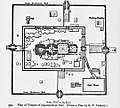 Puri Odisha temple complex plan
Puri Odisha temple complex plan Bhubneshwar Odisha, a smaller temple plan
Bhubneshwar Odisha, a smaller temple plan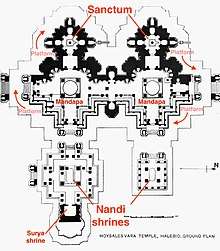 Halebidu Karnataka temple plan
Halebidu Karnataka temple plan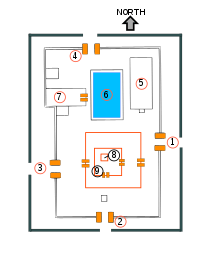 Chidambaram Tamil Nadu temple plan
Chidambaram Tamil Nadu temple plan Thiruvallur, Tamil Hindu temple complex
Thiruvallur, Tamil Hindu temple complex
The builders
The temples were built by guilds of architects, artisans and workmen. Their knowledge and craft traditions, states Michell, were originally preserved by the oral tradition, later with palm-leaf manuscripts.[40] The building tradition was typically transmitted within families from one generation to the next, and this knowledge was jealously guarded. The guilds were like a corporate body that set rules of work and standard wages. These guilds over time became wealthy, and themselves made charitable donations as evidenced by inscriptions.[40] The guilds covered almost every aspect of life in the camps around the site where the workmen lived during the period of construction, which in the case of large projects might be several years.[41]
The work was led by a chief architect (sutradhara). The construction superintendent was equal in his authority.[40] Other important members were stonemason chief and the chief image-maker who collaborated to complete a temple. The sculptors were called shilpins. Women participated in temple building, but in lighter work such as polishing stones and clearing.[40] Hindu texts are inconsistent about which caste did the construction work, with some texts accepting all castes to work as a shilpin.[42] The Brahmins were the experts in art theory and guided the workmen when needed. They also performed consecration rituals of the superstructure and in the sanctum.[43]
In the earliest periods of Hindu art, from about the 4th century to about the 10th century, the artists had considerable freedom and this is evidenced in the considerable variations and innovations in images crafted and temple designs. Later, much of this freedom was lost as iconography became more standardized and the demand for iconometry consistency increased.[43] This "presumably reflected the influence of brahman theologians" states Michell, and the "increasing dependence of the artist upon the brahmins" on suitable forms of sacred images. The "individual pursuit of self-expression" in a temple project was not allowed and instead, the artist expressed the sacred values in the visual form through a temple, for the most part anonymously.[43]
The sponsors used contracts for the building tasks.[43] Though great masters probably had assistants to help complete principal images in a temple, the reliefs panels in a Hindu temple were "almost certainly the inspiration of a single artist".[44]
Schools of temple building tradition
Along with guilds, surviving texts suggest that several schools of Hindu temple architecture had developed in ancient India. Each school developed its own gurukuls (study centres) and texts. Of these, state Bharne and Krusche, two became most prominent: the Vishwakarma school and the Maya school.[45][46] The Vishwakarma school is credited with treatises, terminology and innovations related to the Nagara style of architecture, while the Maya school with those related to the Dravida style.[45][47] The style now called Vesara bridges and combines elements of the Nagara and the Dravida styles, it probably reflects one of the other extinct schools.[48]
Some scholars have questioned the relevance of these texts, whether the artists relied on silpa sastras theory and Sanskrit construction manuals probably written by Brahmins, and did these treatises precede or follow the big temples and ancient sculptures therein. Other scholars question whether big temples and complex symmetric architecture or sculpture with consistent themes and common iconography across distant sites, over many centuries, could have been built by artists and architects without adequate theory, shared terminology and tools, and if so how.[49][45] According to Adam Hardy – an architecture historian and professor of Asian Architecture, the truth "must lie somewhere in between".[49] According to George Michell – an art historian and professor specializing in Hindu Architecture, the theory and the creative field practice likely co-evolved, and the construction workers and artists building complex temples likely consulted the theoreticians when they needed to.[43]
Various styles of architecture
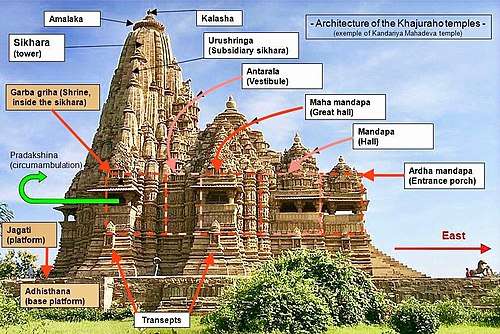
The ancient Hindu texts on architecture such as Brihatsamhita and others, states Michell, classify temples into five orders based on their typological features: Nagara, Dravida, Vesara, ellipse and rectangle. The plan described for each include square, octagonal and apsidal. Their horizontal plan regulates the vertical form. Each temple architecture in turn has developed its own vocabulary, with terms that overlap but do not necessarily mean exactly the same thing in another style and may apply to a different part of the temple.[50] Chronologically, the early Hindu temples are often called classical (up to 7th or 8th century), while those after the classical period through 12th or 13th century are sometimes referred to as medieval. However, states Michell, this is inappropriate for Hindu architecture given India's artistic tradition to conserve its heritage and architectural framework, while evolving ideas.[51]
The style of Hindu temple architecture is not only the result of the theology, spiritual ideas, and the early Hindu texts but also a result of innovation driven by regional availability of raw materials and the local climate.[51] Some materials of construction were imported from distant regions, but much of the temple was built from readily available materials. In some regions, such as in south Karnataka, the local availability of soft stone led to Hoysala architects to innovate architectural styles that are difficult with hard crystalline rocks.[51] In other places, artists cut granite or other stones to build temples and create sculptures. Rock faces allowed artists to carve cave temples or a region's rocky terrain encouraged monolithic rock-cut temple architecture. In regions where stones were unavailable, innovations in brick temples flourished. Hindu temple architecture has historically been affected by the building material available in each region, its "tonal value, texture and structural possibilities" states Michell.[51]
India
Dravida and Nagara architecture
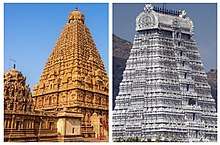
Of the different styles of temple architecture in India, the Nagara architecture of northern India and the Dravidian architecture of southern India are most common.[52] Other styles are also found. For example, the rainy climate and the materials of construction available in Bengal, Kerala, Java and Bali Indonesia have influenced the evolutions of styles and structures in these regions.[53] At other sites such as Ellora and Pattadakal, adjacent temples may have features drawing from different traditions, as well as features in a common style local to that region and period. In modern era literature, many styles have been named after the royal dynasties in whose territories they were built.[54]
| Feature | Nagara architecture[55] | Dravidian architecture[56][57] | Reference |
|---|---|---|---|
| Main temple spire (tower) | Sikhara above sanctum | Vimana that may be multistorey (talas), the top of which is called the sikhara | [58] |
| Mandapa spire (tower) | Yes | No | [59] |
| Curvature of the spire | Curvilinear centred over the sanctum, also straight-edged pyramidal | Straight-edged pyramidal, sometimes curvilinear centred over the sanctum[note 2] | |
| Sanctum | Single or multi-storey | Typically single (Vimana may be multi-storey) | [60] |
| Plan | Mandapa, sanctum and tower plans are predominantly Chaturasra (square); uncommon: Ashtasra, Vritta, Ayatasra, Ayata Ashtasra, Ayata Vritta, Hasti Prishta, Dwayasra Vrita | same, plus Prana Vikara | [60] |
| Gopuram | Not a prominent feature | Characteristic, but not essential; after 10th century often higher than the vimana. May be several, on all sides of the compound, serving as landmarks for pilgrims | |
| Other features | sacred pools, fewer pillared mandapas in temple grounds (separate dharmashala), prakara walls rare (e.g. Odisha after 14th century), single or multiple entrances into temple | sacred pools, many pillared mandapas in temple grounds (used for rites of passage ceremonies, choultry, temple rituals), prakara walls became common after 14th century, single or multiple entrances into temple | [60] |
| Major sub-styles | Latina, Phamsana, Sekhari, Valabhi | Tamil (upper and lower Dravidadesa), Karnata, Andhra | [60] |
| Geography | northern, western and central of the Indian subcontinent | southern parts of the Indian subcontinent, southeast Asia | [60] |
| Chronology of surviving stone-masonry monuments | Late Kushana era, early Gupta: rudimentary archaic; 6th-10th century: zenith | Late Gupta era: rudimentary; 6th-10th century: zenith | [61] |
Regional styles
The architecture of the rock-cut temples, particularly the rathas, became a model for south Indian temples.[62] Architectural features, particularly the sculptures, were widely adopted in South Indian, Cambodian, Annamese and Javanese temples.[63] Descendants of the sculptors of the shrines are artisans in contemporary Mahabalipuram.[64]
Badami Chalukya architecture
The Badami Chalukya Architecture style originated by 5th century in Aihole and was perfected in Pattadakal and Badami.
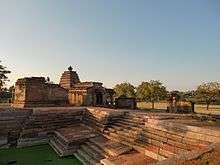
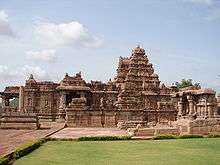
Between 500 and 757 CE, Badami Chalukyas built Hindu temples out of sandstone cut into enormous blocks from the outcrops in the chains of the Kaladgi hills.
In Aihole, known as the "Cradle of Indian architecture," there are over 150 temples scattered around the village. The Lad Khan Temple is the oldest. The Durga Temple is notable for its semi-circular apse, elevated plinth and the gallery that encircles the sanctum sanctorum. A sculpture of Vishnu sitting atop a large cobra is at Hutchimali Temple. The Ravalphadi cave temple celebrates the many forms of Shiva. Other temples include the Konthi temple complex and the Meguti Jain temple.
Pattadakal is a World Heritage Site, where one finds the Virupaksha temple; it is the biggest temple, having carved scenes from the great epics of the Ramayana and the Mahabharata. Other temples at Pattadakal are Mallikarjuna, Kashivishwanatha, Galaganatha and Papanath.
Gadag architecture
The Gadag style of architecture is also called Western Chalukya architecture. The style flourished for 150 years (1050 to 1200 CE); in this period, about 50 temples were built. Some examples are the Saraswati temple in the Trikuteshwara temple complex at Gadag, the Doddabasappa Temple at Dambal, the Kasivisvesvara Temple at Lakkundi, and the Amriteshwara temple at Annigeri. which is marked by ornate pillars with intricate sculpture. This style originated during the period of the Kalyani Chalukyas (also known as Western Chalukya) Someswara I.
- Gadag/Western Chalukya style Architecture of temples
 Stepped floorplan of Dattatreya Temple (one side of the shrine) with five projections at Chattarki in Gulbarga district, 12th century CE
Stepped floorplan of Dattatreya Temple (one side of the shrine) with five projections at Chattarki in Gulbarga district, 12th century CE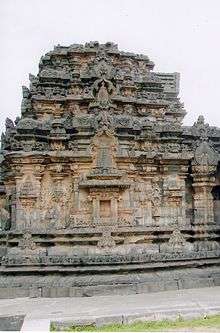 Shrine wall and superstructure in Kasivisvesvara temple at Lakkundi
Shrine wall and superstructure in Kasivisvesvara temple at Lakkundi- Ornate Gadag style pillars at Sarasvati Temple, Trikuteshwara temple complex at Gadag
- Mahadeva Temple at Itagi, Koppal district in Karnataka, also called Devalaya Chakravarti,[68][69] 1112 CE, an example of dravida articulation with a nagara superstructure.
Kalinga architecture


The design which flourished in eastern Indian state of Odisha and Northern Andhra Pradesh are called Kalinga style of architecture. The style consists of three distinct type of temples namely Rekha Deula, Pidha Deula and Khakhara Deula. Deula means "temple" in the local language. The former two are associated with Vishnu, Surya and Shiva temple while the third is mainly with Chamunda and Durga temples. The Rekha deula and Khakhara deula houses the sanctum sanctorum while the Pidha Deula constitutes outer dancing and offering halls.
The prominent examples of Rekha Deula are Lingaraj Temple of Bhubaneswar and Jagannath Temple of Puri. One of the prominent example of Khakhara Deula is Vaital Deula. The Konark Sun Temple is a living example of Pidha Deula.
.jpg)
Māru-Gurjara architecture
Māru-Gurjara architecture, or Solaṅkī style,[70] is a style of north Indian temple architecture that originated in Gujarat and Rajasthan from the 11th to 13th centuries, under the Chaulukya dynasty (or Solaṅkī dynasty).[71] Although originating as a regional style in Hindu temple architecture, it became especially popular in Jain temples and, mainly under Jain patronage, later spread across India and to diaspora communities around the world.[72]
On the exteriors, the style is distinguished from other north Indian temple styles of the period in "that the external walls of the temples have been structured by increasing numbers of projections and recesses, accommodating sharply carved statues in niches. These are normally positioned in superimposed registers, above the lower bands of moldings. The latter display continuous lines of horse riders, elephants, and kīrttimukhas. Hardly any segment of the surface is left unadorned." The main shikhara tower usually has many urushringa subsidiary spirelets on it, and two smaller side-entrances with porches are common in larger temples.[72]
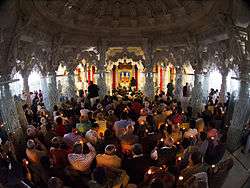
Interiors are if anything even more lavishly decorated, with elaborate carving on most surfaces. In particular, Jain temples often have small low domes carved on the inside with a highly intricate rosette design. Another distinctive feature is "flying" arch-like elements between pillars, touching the horizontal beam above in the centre, and elaborately carved. These have no structural function, and are purely decorative. The style developed large pillared halls, many open at the sides, with Jain temples often having one closed and two pillared halls in sequence on the main axis leading to the shrine.[73]
The style mostly fell from use in Hindu temples in its original regions by the 13th century, especially as the area had fallen to the Muslim Delhi Sultanate by 1298. But, unusually for an Indian temple style, it continued to be used by Jains there and elsewhere, with a notable "revival" in the 15th century.[74] Since then it has continued in use in Jain and some Hindu temples, and from the late 20th century has spread to temples built outside India by both the Jain diaspora and Hindus. Some buildings mix Māru-Gurjara elements with those of local temple styles and modern international ones. Generally, where there is elaborate carving, often still done by craftsmen from Gujarat or Rajasthan, this has more ornamental and decorative work than small figures. In particular the style is used in India and abroad by the Swaminarayan sect. Sometimes the Māru-Gurjara influence is limited to the "flying arches" and mandapa ceiling rosettes, and a preference for white marble.[72]
Southeast Asia as part of Greater India
Architecture of the southeast nations was inspired by the Indian temple architecture,[62][63] as those were Indianised as part of the Greater India.
Champa architecture
Between the 6th and the 16th century, the Kingdom of Champa flourished in present-day central and southern Vietnam. Unlike the Javanese that mostly used volcanic andesite stone for their temples, and Khmer of Angkor which mostly employed grey sandstones to construct their religious buildings, the Cham built their temples from reddish bricks. The most important remaining sites of Cham bricks temple architecture include Mỹ Sơn near Da Nang, Po Nagar near Nha Trang, and Po Klong Garai near Phan Rang.
Typically, a Cham temple complex consisted of several different kinds of buildings.[75] They are kalan, a brick sanctuary, typically in the form of a tower with garbahgriha used to host the murti of deity. A mandapa is an entry hallway connected with a sanctuary. A kosagrha or "fire-house" is a temple construction typically with a saddle-shaped roof, used to house the valuables belonging to the deity or to cook for the deity. The gopura was a gate-tower leading into a walled temple complex. These building types are typical for Hindu temples in general; the classification is valid not only for the architecture of Champa, but also for other architectural traditions of Greater India.
Indonesian architecture
Temples are called candi (pronounced [tʃandi]) in Indonesia, whether it is Buddhist or Hindu. A Candi refers to a structure based on the Indian type of single-celled shrine, with a pyramidal tower above it (Meru tower in Bali), and a portico for entrance,[76] mostly built between the 7th to 15th centuries.[76][77] In Hindu Balinese architecture, a candi shrine can be found within a pura compound. The best example of Indonesian Javanese Hindu temple architecture is the 9th century Prambanan (Shivagrha) temple compound, located in Central Java, near Yogyakarta. This largest Hindu temple in Indonesia has three main prasad towers, dedicated to Trimurti gods. Shiva temple, the largest main temple is towering to 47 metre-high (154 ft).
The term "candi" itself is believed was derived from Candika, one of the manifestations of the goddess Durga as the goddess of death.[78]
The candi architecture follows the typical Hindu architecture traditions based on Vastu Shastra. The temple layout, especially in central Java period, incorporated mandala temple plan arrangements and also the typical high towering spires of Hindu temples. The candi was designed to mimic Meru, the holy mountain the abode of gods. The whole temple is a model of Hindu universe according to Hindu cosmology and the layers of Loka.[79]
The candi structure and layout recognize the hierarchy of the zones, spanned from the less holy to the holiest realms. The Indic tradition of Hindu-Buddhist architecture recognize the concept of arranging elements in three parts or three elements. Subsequently, the design, plan and layout of the temple follows the rule of space allocation within three elements; commonly identified as foot (base), body (centre), and head (roof). They are Bhurloka represented by the outer courtyard and the foot (base) part of each temples, Bhuvarloka represented by the middle courtyard and the body of each temples, and Svarloka which symbolized by the roof of Hindu structure usually crowned with ratna (sanskrit: jewel) or vajra.
Khmer architecture
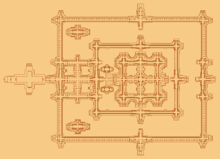

Before the 14th century, the Khmer Empire flourished in present-day Cambodia with its influence extended to most of mainland Southeast Asia. Its great capital, Angkor (Khmer: អង្គរ, "Capital City", derived from Sanskrit "nagara"), contains some of the most important and the most magnificent example of Khmer temple architecture. The classic style of Angkorian temple is demonstrated by the 12th century Angkor Wat. Angkorian builders mainly used sandstone and laterite as temple building materials.
The main superstructure of typical Khmer temple is a towering prasat called prang which houses the garbhagriha inner chamber, where the murti of Vishnu or Shiva, or a lingam resides. Khmer temples were typically enclosed by a concentric series of walls, with the central sanctuary in the middle; this arrangement represented the mountain ranges surrounding Mount Meru, the mythical home of the gods. Enclosures are the spaces between these walls, and between the innermost wall and the temple itself. The walls defining the enclosures of Khmer temples are frequently lined by galleries, while passage through the walls is by way of gopuras located at the cardinal points. The main entrance usually adorned with elevated causeway with cruciform terrace.[80]
Glossary
The Hindu texts on temple architecture have an extensive terminology. Most terms have several different names in the various Indian languages used in different regions of India, as well as the Sanscrit names used in ancient texts. A few of the more common terms are tabulated below, mostly in their Sanscrit/Hindi forms:[81]
| Term | Explanation | Synonyms or Similar | Illustrative Hindu text mention / design rules |
Reference | Image |
|---|---|---|---|---|---|
| Adhisthana | stylobate, plinth, base typically with mouldings on the side, on which a temple building or pillar stands | Athavaksham, Pista, Pitha | Manasara XIV, Kamikagama 35, Suprabhedagama 31 | [82] |  |
| Amalaka | a crowning ornament on the top of shikara, shape of an Indian amalok fruit that looks like a cogged wheel. The amalaka supports the kalasha. | Mayamata silpasastra | [82][83] |  | |
| Antarala | lit. interior space of any building; in temples, it is the intermediate space (vestibule, antechamber) between the sanctum and space where pilgrims gather | Sukhanasi | Manasara XV, XXIII; Kamikagama XXXV | [82][83] | 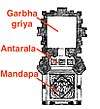 |
| Ardhamandapa | half hall at each entrance, usually the reception area that connects to the mandapa | Manasara XIV, Kamikagama 35, Suprabhedagama 31 | [82] | 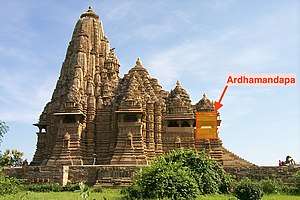 | |
| Ayatana | assembly hall, grounds inside a temple or monastery compound | Agni Purana XLIII, Matsya Purana CCLXX, Chandogya Upanishad 6.8.2 | [84] | ||
| Bhadra | a projection often aligned to one of the cardinal directions; typically of central part of walls; decoration or a projected porch for pilgrims; also may be a tower storey projection | Manasara XXX-XXXIV | [82] | ||
| Gana | a mythical dwarf or goblin usually with a protruded belly and with humorous expression | [85] |  | ||
| Garbhagriha | The womb-house, adytum, sanctum sanctorum; it is the loci of the temple and the darshana, the spiritual space that Hindus circumambulate clockwise about. This is where the main murti image is placed. Usually the space is very plain, with no distractions from the murti, which is rich in symbolism. A large temple may have many shrines, each with a garbhagriya. | Garbha-griya, Garbha-geha, Sibika, Garbha, Mula-sthana | Brihat Samhita LXI | [81] |  |
| Gavaksha | one of the arch motifs; it is horseshoe-shaped, found with windows or for decorating spires, pillars and other elements | Gavaksa, kudu | [86][87] | ||
| Gopuram | a gateway at entrance or one that connects two sacred spaces of the temple; becomes very large in South Indian temples, which may have several; it has roots in ancient Indian monasteries and the Vedic word gomatipur;[88] | Gopura, Dvara attalaka | Agni Purana XLII, Manasara XI, XXXIII verses 1-601, LVIII | [89][90] |  |
| Hara | neck ornament such as necklace | [91] | 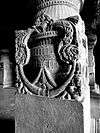 | ||
| Jala | a trellis, stone grille, net, first seen in 6th-century temples | Jali, Indra koshtha | [92] | 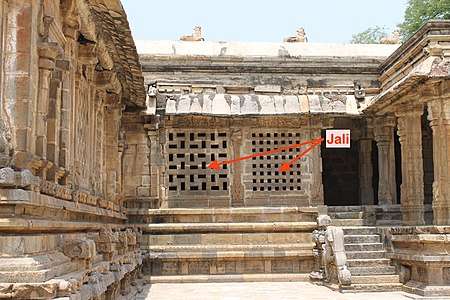 | |
| Jagati | any moulded base or pedestal for the temple or a statue that extends out, part of platform that forms a terrace to stand on or circumambulate around on, while reading the reliefs and friezes | Jagata, Pithika, Jagati-pitha, Kati, Vasudha | Samarangana-sutradhara LXVIII, Agni Purana XLII, Suprabhedagama 31.19 | [82][93] |  |
| Kalasha | the pinnacle element of a temple, a vase finial, cupola or pitcher | Kalasam, Stupi, Kumuda | Agni Purana CIV, Kamikagama 55 | [85][94] |  |
| Kunda | temple tank, stepwell, pool, usually with steps, public utility for taking a dip; often connected to a nearby river or mountain stream | Pushkarani, Sara, Sagar, Tadaga, Udapana, Var, Vapi | Garuda Purana XLVI, Mahanirvana tantra XIII | [95] | 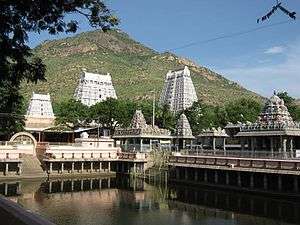 |
| Lata | liana, creeper-style plant, vine, one type of scroll work; also found on sikhara | [96] | |||
| Makara | a mythical fusion sea creature with fish-crocodile like face, trunk or snout, legs sometimes with lion claws and a tail; vahana of Varuna | Suprabhedagama 31.68-72 | [97] |  | |
| Mandapa | pillared hall or pavilion, with pillars usually carved; a mandapa is typically square, rectangle, octagonal or circular; it may have walls with perforated stone windows, it may just be open on some or all sides. Large temples may have many interconnected mandapas. It is a gathering place, a place for pilgrims to rest (choultry), a part of the circumambulation space, or to wait during prayers or Sanskara (rite of passage) rituals. A mandapa may have a tower (shikhara) of its own, but it is lower than that above the sanctum. | Mandapam, Mantapa, Jagamohan | Manasara XXXII-XXXIV, Kamikagama 50, Brihat samhita, Vishnu Purana 6.124-136 | [98][89][99] |  |
| Mulaprasada | main shrine in a temple complex | [98] | |||
| Nisha | niche on temple walls or in pillars for sculptures or stele | [100] | |||
| Nyasa | the art of arranging images and friezes to create a narrative or composition, in some texts it refers to relative placement of images within a panel to summarize a Hindu legend or fable; also a form a ritual. | Vastusutra Upanishad VI | [100][101] | ||
| Prakara | wall that separates an inner zone of temple ground from an outer zone; typically concentric, defensive and fortified, a feature added after the wars and plunders starting in the 14th-century | [102][103] |  | ||
| Prastara | entablature, horizontal superstructure of bands and moldings above column capitals, sometimes functions as a parapet of a storey | Chaiva, gopanam, kapotam, mancham | Manasara XVI; Kamikagama LIV | [104][105][106] |  |
| Ratha | a facet or vertical offset projection on the plan of the sanctum and shikhara above, or other structure. It is generally carried up from the bottom of the temple to the superstructure. A ratha, meaning cart, is also the temple chariot used for processing the murti at festivals, and a "ratha temple" is one designed to resemble a cart, with wheels on the sides, and often horses. The most famous example is the Sun Temple, Konarak. | [107] | |||
| Sala | Round barrel-roofed, wagon-roofed pavilion; rooted in the thatched roofed stall for people or cattle tradition, then other materials of construction; any mansion or griha; a pilgrim services building with mandapas or pillared veranda or both inside the temple complex, Hindu texts describe multi-storey Sala; in south, sala are structures used as a decorative motif, or an actual roof, as at the top of gopurams; rooted in ancient thatched roof styles. | Chala | Manasara XXXV verses 1-404 | [108][109] | .jpg) |
| Sikhara/Vimana | In North India, the tower above the sanctum (entire spire above mulaprasada); in South India, that top part of tower that is above the vimana | Shikhara, Sikha, Sikhanta, Sikhamani, Deul in East India, Garbhaka, Garbhamandira | Brihat Samhita LVI | [110][111][112] |  |
| Stambha | A pillar; it can be a load bearing element or an independent standing element with diya (lamps) and Hindu icons below, around and / or on top; the designs vary significantly by region, in Kerala Hindu temples they are at the entrance; on festive occasions the wick lamps are loaded with oil and lit up. | Kambha, Dwajasthampam, Kodimaram | Manasara XV, Kasyapa silpa sastra IX | [113] | 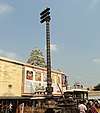 |
| Sukanasa | an external ornamented feature over the entrance to the garbhagriha or inner shrine. It sits on the face of the sikhara tower (in South India, the vimana) as a sort of antefix. Can refer to the antarala below as well. | sukanasa-sika | Agni Purana XLII | [114] | 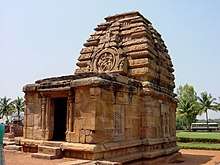 |
| Tala | tier or storey of a shikhara, vimana or gopuram | [110] | |||
| Torana | any arch or canopy motif, ornament or architectural member in temples and buildings; it also refers to an arched gateway | Numerous terms, e.g. Gavaksha (from 'cow eye'-shaped) | Garuda Purana XLVII, Manasara XLVI verses 1-77 | [115] |  |
| Urushringa | subsidiary turret-like shikharas on the side of the main shikhara; the primary turret is called shringa | Brihat Samhita LVI, Agni Purana CIV | [116][117] | 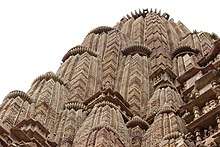 |
Gallery
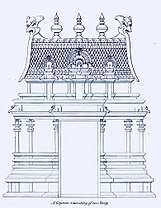 Single storey gopura (Dravidian architecture)
Single storey gopura (Dravidian architecture) Two storey gopura (Dravidian architecture)
Two storey gopura (Dravidian architecture) Pillar elements (shared by Nagara and Dravidian)
Pillar elements (shared by Nagara and Dravidian) Athisthana architectural elements of a Hindu temple
Athisthana architectural elements of a Hindu temple Entablature elements
Entablature elements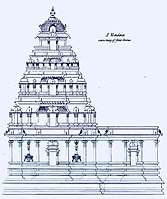 A vimana with mandapam elements (Dravidian architecture)
A vimana with mandapam elements (Dravidian architecture)
See also
| Wikimedia Commons has media related to Temple architecture of India. |
- Temple tank
- Vedic altars
- Indonesian architecture, Candi of Indonesia
- Rock-cut architecture
- Indian rock-cut architecture
- Architecture of Angkor
- Hemadpanthi architecture Style
- Dwajasthambam (flagstaff)
Notes
- Richard Salomon dates the earliest Cambodian Sanskrit inscriptions to the 5th century.[20]
- In rare cases, such as the Brihadishvara temple at Gangaikondacholapuram, the centre is outside the temple.
References
- These are the usual terms, but there are many variants or different ones in the many Indian languages, ancient and modern.
- Stella Kramrisch, The Hindu Temple, Vol 1, Motilal Banarsidass, ISBN 978-81-208-0222-3
- George Michell 1988, pp. 60-61.
- Jack Hebner (2010), Architecture of the Vastu Sastra - According to Sacred Science, in Science of the Sacred (Editor: David Osborn), ISBN 978-0557277247, pp 85-92; N Lahiri (1996), Archaeological landscapes and textual images: a study of the sacred geography of late medieval Ballabgarh, World Archaeology, 28(2), pp 244-264
- BB Dutt (1925), Town planning in Ancient India at Google Books, ISBN 978-81-8205-487-5
- Meister, Michael (1983). "Geometry and Measure in Indian Temple Plans: Rectangular Temples". Artibus Asiae. 44 (4): 266–296. doi:10.2307/3249613. JSTOR 3249613.
- "Ellora Caves". UNESCO World Heritage Centre. Retrieved 2019-02-28.
- Harle (1994), 87-100; Michell (1988), 18
- Meister, Michael W. (1988–1989). "Prāsāda as Palace: Kūṭina Origins of the Nāgara Temple". Artibus Asiae. 49 (3–4): 254–256. doi:10.2307/3250039. JSTOR 3250039.
- Michael Meister (1987), Hindu Temple, in The Encyclopedia of Religion, editor: Mircea Eliade, Volume 14, Macmillan, ISBN 0-02-909850-5, page 370
- Michell (1990), 192
- Michell (1990), 157; Michell (1988), 96
- Meister, Michael W. (1988–1989). "Prāsāda as Palace: Kūṭina Origins of the Nāgara Temple". Artibus Asiae. 49 (3–4): 254–280. doi:10.2307/3250039. JSTOR 3250039.
- Harle, 136-138; Michell (1988), 90, 96-98
- Michael W. Meister and M.A. Dhaky (1983), South India: Lower Dravidadesa, Encyclopaedia of Indian Temple Architecture, Vol. I, Part I, Princeton University Press, ISBN 978-0691784021, pages 30-53
- Michell (1988), 18, 50-54, 89, 149-155; Harle (1994), 335
- George Michell 1995, pp. 9-10, Quote: "The era under consideration opens with an unprecedented calamity for Southern India: the invasion of the region at the turn of the fourteenth century by Malik Kafur, general of Alauddin, Sultan of Delhi. Malik Kafur's forces brought to an abrupt end all of the indigenous ruling houses of Southern India, not one of which was able to withstand the assault or outlive the conquest. Virtually every city of importance in the Kannada, Telugu and Tamil zones succumbed to the raids of Malik Kafur; forts were destroyed, palaces dismantled and temple sanctuaries wrecked in the search for treasure. In order to consolidate the rapidly won gains of this pillage, Malik Kafur established himself in 1323 at Madurai (Madura) in the southernmost part of the Tamil zone, former capital of the Pandyas who were dislodged by the Delhi forces. Madurai thereupon became the capital of the Ma'bar (Malabar) province of the Delhi empire.".
- Sen, Võ Văn; Thắng, Đặng Văn (2017-10-06). "Recognition of Oc Eo Culture Relic in Thoai Son District an Giang Province, Vienam". American Scientific Research Journal for Engineering, Technology, and Sciences (ASRJETS). 36 (1): 271–293. ISSN 2313-4402.
- Keat Gin Ooi (2004). Southeast Asia: A Historical Encyclopedia, from Angkor Wat to East Timor. ABC-CLIO. pp. 587–588. ISBN 978-1-57607-770-2.
- Richard Salomon (1998). Indian Epigraphy: A Guide to the Study of Inscriptions in Sanskrit, Prakrit, and the other Indo-Aryan Languages. Oxford University Press. pp. 155–157. ISBN 978-0-19-535666-3.
- Michell (1988), 18-19, 54, 159-182
- Richard Salomon (1990). "Indian Tirthas in Southeast Asia". In Hans Bakker (ed.). The History of Sacred Places in India As Reflected in Traditional Literature: Papers on Pilgrimage in South Asia. BRILL Academic. pp. 160–176. ISBN 978-90-04-09318-8., Quote: "In the Indianized regions of ancient southeast Asia, comprising the modern nations of Burma, Thailand, Malaysia, Cambodia, Laos, Vietnam and Indonesia (...)"
- George Michell 1988, pp. 159-161.
- "Prambanan - Taman Wisata Candi". borobudurpark.com. Retrieved 2017-12-15.
- Centre, UNESCO World Heritage. "Angkor". whc.unesco.org. Retrieved 2017-12-15.
- Susan Lewandowski, The Hindu Temple in South India, in Buildings and Society: Essays on the Social Development of the Built Environment, Anthony D. King (Editor), ISBN 978-0710202345, Routledge, Chapter 4
- Alain Daniélou (2001), The Hindu Temple: Deification of Eroticism, Translated from French to English by Ken Hurry, ISBN 0-89281-854-9, pp 101-127
- Samuel Parker (2010), Ritual as a Mode of Production: Ethnoarchaeology and Creative Practice in Hindu Temple Arts, South Asian Studies, 26(1), pp 31-57; Michael Rabe, Secret Yantras and Erotic Display for Hindu Temples, (Editor: David White), ISBN 978-8120817784, Princeton University Readings in Religion (Motilal Banarsidass Publishers), Chapter 25, pp 435-446
- Stella Kramrisch, The Hindu Temple, Vol 1, Motilal Banarsidass, ISBN 978-81-208-0222-3, page 5-6
- Michell (1988), 50
- Susan Lewandowski, The Hindu Temple in South India, in Buildings and Society: Essays on the Social Development of the Built Environment, Anthony D. King (Editor), ISBN 978-0710202345, Routledge, pp 68-69
- Stella Kramrisch (1976), The Hindu Temple Volume 1 & 2, ISBN 81-208-0223-3
- In addition to square (4) sided layout, Brhat Samhita also describes Vastu and mandala design principles based on a perfect triangle (3), hexagon (6), octagon (8) and hexadecagon (16) sided layouts, according to Stella Kramrisch. The 49 grid design is called Sthandila and of great importance in creative expressions of Hindu temples in South India, particularly in ‘‘Prakaras’’.
- Meister, Michael W. (March 2006). "Mountain Temples and Temple-Mountains: Masrur". Journal of the Society of Architectural Historians. 65 (1): 26–49. doi:10.2307/25068237. JSTOR 25068237.
- Stella Kramrisch 1976, p. 8.
- Trivedi, K. (1989). Hindu temples: models of a fractal universe. The Visual Computer, 5(4), 243-258
- Susan Lewandowski, The Hindu Temple in South India, in Buildings and Society: Essays on the Social Development of the Built Environment, Anthony D. King (Editor), ISBN 978-0710202345, Routledge, pp 71-73
- Meister, Michael W. (April–June 1979). "Maṇḍala and Practice in Nāgara Architecture in North India". Journal of the American Oriental Society. 99 (2): 204–219. doi:10.2307/602657. JSTOR 602657.
- Vinayak Bharne & Krupali Krusche 2014, pp. 66-69 with Figure 5.8.
- Michell (1988), 55–56 with Figure 20
- Michell (1988), 55-57
- Stella Kramrisch (1994), Exploring India's Sacred Art, Editor: Stella Miller, Motilal Banarsidass, ISBN 978-81-208-1208-6, pages 60–64
- Michell (1988), 54-55, 57
- Michell (1988), 57
- Vinayak Bharne & Krupali Krusche 2014, pp. 66-72.
- Madhusudan A. Dhaky (1977). The Indian Temple Forms in Karṇāṭa Inscriptions and Architecture. Abhinav Publications. pp. 1–19. ISBN 978-81-7017-065-5.
- Tarapada Bhattacharyya (1986). The Canons of Indian Art: Or, a Study on Vāstuvidyā. Firma KLM. pp. i–v, 87–99, 201–204, 291–292. ISBN 978-0-8364-1618-3.
- Tarapada Bhattacharyya (1986). The Canons of Indian Art: Or, a Study on Vāstuvidyā. Firma KLM. pp. 155–163. ISBN 978-0-8364-1618-3.
- Hardy, Adam (2009). "Drāvida Temples in the Samarānganasūtradhāra" (PDF). South Asian Studies. 25 (1): 41–62. doi:10.1080/02666030.2009.9628698.
- George Michell 1988, p. 88.
- George Michell 1988, p. 88-89.
- Hardy (1995), 5; Michell (1988), 88-89
- George Michell 1988, pp. 89, 155-158.
- Michell (1988), 155-182; Hardy (1995), 5-10
- Madhusudan A. Dhaky (1977). The Indian Temple Forms in Karṇāṭa Inscriptions and Architecture. Abhinav Publications. pp. 7–13. ISBN 978-81-7017-065-5.
- Hardy (1995), 5-8
- Madhusudan A. Dhaky (1977). The Indian Temple Forms in Karṇāṭa Inscriptions and Architecture. Abhinav Publications. pp. 14–19. ISBN 978-81-7017-065-5.
- Vinayak Bharne & Krupali Krusche 2014, p. 68-70, 74-75.
- Vinayak Bharne & Krupali Krusche 2014, p. 68-70.
- Vinayak Bharne & Krupali Krusche 2014, p. 66-70.
- Madhusudan A. Dhaky (1977). The Indian Temple Forms in Karṇāṭa Inscriptions and Architecture. Abhinav Publications. pp. 7–19. ISBN 978-81-7017-065-5.
- "The Rathas, monolithic [Mamallapuram]". Online Gallery of British Library. Retrieved 23 October 2012.
- Bruyn, Pippa de; Bain, Keith; Allardice, David; Shonar Joshi (18 February 2010). Frommer's India. John Wiley & Sons. pp. 333–. ISBN 978-0-470-64580-2. Retrieved 7 February 2013.
- Himanshu Prabha Ray (2010). Archaeology and Text: The Temple in South Asia. Oxford University Press. pp. 17–18, 27. ISBN 978-0-19-806096-3.
- Heather Elgood 2000, p. 151.
- Jeffery D. Long (2011). Historical Dictionary of Hinduism. Scarecrow. p. 29. ISBN 978-0-8108-7960-7., Quote: "AIHOLE. Pronounced "Eye-ho-lé", village in northern Karnataka that, from the fourth to the sixth centuries CE, was a major city (...)"
- Cousens (1926), p. 101
- Kamath (2001), pp. 117–118
- Hegewald, note 3. Mitchell (1988) uses "Solanki style", while Harle is reluctant to tie the style to a specific name.
- Mitchell (1988), 123; Hegewald
- Hegewald
- Hegewald; Harle, 219–220
- Harle, 239–240; Hegewald
- Tran Ky Phuong, Vestiges of Champa Civilization.
- Philip Rawson: The Art of Southeast Asia
- Soekmono (1995), p. 1
- Soekmono, Dr R. (1973). Pengantar Sejarah Kebudayaan Indonesia 2. Yogyakarta, Indonesia: Penerbit Kanisius. p. 81. ISBN 978-979-413-290-6.
- Sedyawati (2013), p. 4
- Glaize, Monuments of the Angkor Group, p.27.
- http://personal.carthage.edu/jlochtefeld/picturepages/Khajuraho/architecture.html
- Adam Hardy 1995, p. 387.
- Vinayak Bharne & Krupali Krusche 2014, p. 283.
- Prasanna Kumar Acharya 2010, pp. 59-60.
- Adam Hardy 1995, p. 388.
- Vinayak Bharne & Krupali Krusche 2014, p. 73-80.
- George Michell 2000, pp. 39-44.
- Prasanna Kumar Acharya 2010, p. 157.
- Vinayak Bharne & Krupali Krusche 2014, p. 284.
- Prasanna Kumar Acharya 2010, pp. 157-161.
- Alice Boner & Sadāśiva Rath Śarmā 2005, p. 147.
- Prasanna Kumar Acharya 2010, pp. 68, 190.
- Stella Kramrisch 1976, p. 145 with footnote 44.
- Prasanna Kumar Acharya 2010, pp. 108-109.
- Prasanna Kumar Acharya 2010, pp. 74, 162, 192, 312, 454.
- Alice Boner & Sadāśiva Rath Śarmā 2005, p. 151.
- Prasanna Kumar Acharya 2010, pp. 219, 389.
- Adam Hardy 1995, p. 389.
- Prasanna Kumar Acharya 2010, pp. 468-489, 513.
- Alice Boner & Sadāśiva Rath Śarmā 2005, p. 154.
- Alice Boner; Sadāśiva Rath Śarmā; Bettina Bäumer (1996). The essence of form in sacred art. Motilal Banarsidass. pp. 79–99. ISBN 978-81-208-0090-8.
- Vinayak Bharne & Krupali Krusche 2014, p. 285.
- O. M. Starza (1993). The Jagannatha Temple at Puri: Its Architecture, Art, and Cult. BRILL Academic. pp. 20–21. ISBN 978-90-04-09673-8.
- Adam Hardy 1995, p. 82, 390.
- Vinayak Bharne & Krupali Krusche 2014, pp. 112, 126-130, 149-152, 280.
- Prasanna Kumar Acharya 2010, pp. 328-336.
- Harle, 153, 252
- Harle (1994), pp. 148, 158, 280, 301
- Prasanna Kumar Acharya 2010, pp. 484-489.
- Adam Hardy 1995, p. 390.
- Prasanna Kumar Acharya 2010, pp. 490-491.
- Alice Boner & Sadāśiva Rath Śarmā 2005, p. 158.
- Vinayak Bharne & Krupali Krusche 2014, p. 148-149.
- Prasanna Kumar Acharya 2010, pp. 495-496.
- Prasanna Kumar Acharya 2010, pp. 148-149.
- Harle (1994), 219
- Prasanna Kumar Acharya 2010, pp. 470-471.
Bibliography
- Prasanna Kumar Acharya (2010), An encyclopaedia of Hindu architecture, Oxford University Press (Republished by Motilal Banarsidass), ISBN 978-81-7536-534-6
- Prasanna Kumar Acharya (1997). A Dictionary of Hindu Architecture: Treating of Sanskrit Architectural Terms with Illustrative Quotations. Oxford University Press (Reprinted in 1997 by Motilal Banarsidass). ISBN 978-81-7536-113-3.
- Prasanna Kumar Acharya (1996). Hindu Architecture in India and Abroad. Laurier. ISBN 978-81-215-0732-5.
- Vinayak Bharne; Krupali Krusche (2014), Rediscovering the Hindu Temple: The Sacred Architecture and Urbanism of India, Cambridge Scholars Publishing, ISBN 978-1-4438-6734-4
- Alice Boner (1990). Principles of Composition in Hindu Sculpture: Cave Temple Period. Motilal Banarsidass. ISBN 978-81-208-0705-1.
- Alice Boner; Sadāśiva Rath Śarmā (2005), Silpa Prakasa, Brill Academic (Reprinted by Motilal Banarsidass), ISBN 978-8120820524
- A.K. Coomaraswamy; Michael W. Meister (1995). Essays in Architectural Theory. Indira Gandhi National Centre for the Arts. ISBN 978-0-19-563805-9.
- Dehejia, V. (1997). Indian Art. Phaidon: London. ISBN 0-7148-3496-3.
- Adam Hardy (1995), Indian Temple Architecture: Form and Transformation, Abhinav Publications, ISBN 978-81-7017-312-0
- Adam Hardy (2007). The Temple Architecture of India. Wiley. ISBN 978-0470028278.
- Adam Hardy (2015). Theory and Practice of Temple Architecture in Medieval India: Bhoja's Samarāṅgaṇasūtradhāra and the Bhojpur Line Drawings. Indira Gandhi National Centre for the Arts. ISBN 978-93-81406-41-0.
- Hardy, Adam (2007). The Temple Architecture of India, Wiley: Chichester. ISBN 978-0-470-02827-8
- Hegewald, Julia A. B. (2011). "The International Jaina Style? Māru-Gurjara Temples Under the Solaṅkīs, throughout India and in the Diaspora". Ars Orientalis. 45. doi:10.3998/ars.13441566.0045.005. ISSN 2328-1286.
- Harle, J.C., The Art and Architecture of the Indian Subcontinent, 2nd edn. 1994, Yale University Press Pelican History of Art, ISBN 0300062176
- Knut A. Jacobsen; Helene Basu; Angelika Malinar; et al. (2009). Brill's Encyclopedia of Hinduism: Sacred texts, ritual traditions, arts, concepts. Brill Academic. ISBN 978-90-04-17893-9.
- Monica Juneja (2001). Architecture in Medieval India: Forms, Contexts, Histories. Orient Blackswan. ISBN 978-8178242286.
- Stella Kramrisch (1976), The Hindu Temple Volume 1, Motilal Banarsidass (Reprinted 1946 Princeton University Press), ISBN 978-81-208-0223-0
- Stella Kramrisch (1979). The Hindu Temple Volume 2. Motilal Banarsidass (Reprinted 1946 Princeton University Press). ISBN 978-81-208-0224-7.
- Michael W. Meister; Madhusudan Dhaky (1986). Encyclopaedia of Indian temple architecture. American Institute of Indian Studies. ISBN 978-0-8122-7992-4.
- George Michell (1988), The Hindu Temple: An Introduction to Its Meaning and Forms, University of Chicago Press, ISBN 978-0-226-53230-1
- George Michell (2000), Hindu Art and Architecture, Thames & Hudson, ISBN 978-0-500-20337-8
- Michell, George (1990), The Penguin Guide to the Monuments of India, Volume 1: Buddhist, Jain, Hindu, 1990, Penguin Books, ISBN 0140081445
- George Michell (1995), Architecture and Art of Southern India, Cambridge University Press, ISBN 978-0-521-44110-0
- T. A. Gopinatha Rao (1993). Elements of Hindu iconography. Motilal Banarsidass. ISBN 978-81-208-0878-2.
- Rajan, K.V. Soundara (1998). Rock-Cut Temple Styles. Somaiya Publications: Mumbai. ISBN 81-7039-218-7
- Ajay J. Sinha (2000). Imagining Architects: Creativity in the Religious Monuments of India. University of Delaware Press. ISBN 978-0-87413-684-5.
- Stella Snead; Wendy Doniger; George Michell (1989). Animals in Four Worlds: Sculptures from India. University of Chicago Press. ISBN 978-0-226-76726-0.
- D Srinivasan (1997). Many Heads, Arms, and Eyes: Origin, Meaning, and Form of Multiplicity in Indian Art. BRILL Academic. ISBN 978-90-04-10758-8.
- Burton Stein (1978). South Indian Temples. Vikas. ISBN 978-0706904499.
- Burton Stein (1989). The New Cambridge History of India: Vijayanagara. Cambridge University Press. ISBN 978-0-521-26693-2.
- Burton Stein; David Arnold (2010). A History of India. John Wiley & Sons. ISBN 978-1-4443-2351-1.
- Kapila Vatsyayan (1997). The Square and the Circle of the Indian Arts. Abhinav Publications. ISBN 978-81-7017-362-5.
External links
- Sabha, Vedic altar, Indian temples and Buddhist Mandala: Drawings, Patrick George, University of Pennsylvania
- Space and Cosmology in the Hindu Temple
- Hindu Javanese Temples
